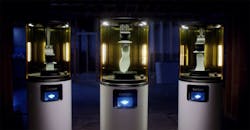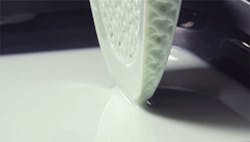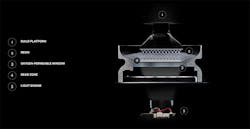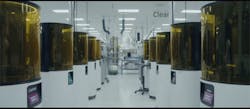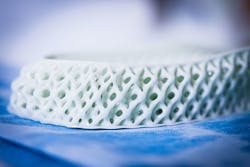Adidas Hurdles Manufacturing Limits with Liquid & Light
Adidas’ 3D-printed FutureCraft shoe line is so far ahead of the pack that now traditional 3D printing is too outdated for its manufacturing plans. Using a process developed by Carbon called Digital Light Syntheses (DLS), Adidas can now create infinitely customizable midsoles for its FutureCraft 4D shoes, all while measuring manufacturing time in minutes instead of hours.
Previously, Adidas could prototype midsoles using 3DP, though were constrained by the geometries compression and injection moldings could make. This new combination of liquid and light, like other 3D printing solutions, is untethered by such limits, with the bleeding edge benefit of quickly producing strong, scalable parts ready for the end-user.
Photo: Adidas
“With Digital Light Synthesis, we venture beyond limitations of the past, unlocking a new era in design and manufacturing — one driven by athlete data and agile manufacturing processes,” says Adidas executive Eric Liedtke. “By charting a new course for our industry, we can unleash our creativity - transforming not just what we make, but how we make it.”
DLS uses Carbon’s photo-chemical process called CLIP, which projects light upward through an oxygen-permeable window — and a thin “dead zone” of uncured resin — to shape the part as it rises from a reservoir of programmable, UV-curable resin.
Components of Digital Light Synthesis
“I think of light as a chisel,” says Joseph Desimone, Carbon co-founder and CEO. “Light triggers the solidification of the liquid, but oxygen inhibits it. That allows us to have the object grow.”
Midsoles that had taken several hours to make now take less than one. Post processing is also greatly reduced. Adidas anticipates releasing more than 100,000 pairs by the end of 2018, with 300 pairs out now and 5,000 expected for Fall 2017.
Photo: Adidas
This revolutionary production method could increase exponentially from tens of thousands to tens of millions, Desimone says.
Carbon claims DLS will make injection molded plastics obsolete by comparison.
Screengrab: Carbon/ Vimeo
Jon Munns, Adidas’ Future senior design director, calls it “the convergence of a completely new manufacturing technology.”
It should come as no surprise that the first manufacturer to kick off the next phase of additive manufacturing would be a shoe company. Along with freeing a designer from the geometrical constraints of traditional manufacturing methods, 3DP allows for interminable customization. And if there’s one thing on your body you want to truly fit like a glove, it’s definitely your shoe.
A Size 9 for someone that weighs 180 lb. shouldn’t be the same as for someone who weighs 100 lb., Adidas designer Jacques Perrault notes.
And now they don’t have to be.
The intricate lattice patterns leverage 17 years of running data Adidas has collected and can be formed to ergonomically fit feet better, so pounding the pavement will feel more like skipping on clouds. The polymeric structure can be designed for different sports, or for unique users. Adidas’ end game will be to someday custom print shoes for customers the same way optometrists produce eyeglasses.
Photo: Adidas
The Futurecraft is not the only shoe company experimenting with 3D printing, as Nike, New Balance, Under Armor and Reebok all have programs in place. Reebok has partnered with Rize, another upstart 3D printing company that uses innovative materials and reduces post-processing.
Adidas, is however, at this point, outpacing its competitors, and possibly all other manufacturers, by launching a product that represents what people envision 3D printing should be: flexible, fast, customizable, and most importantly, high-volume.
About the Author
John Hitch
Editor, Fleet Maintenance
John Hitch, based out of Cleveland, Ohio, is the editor of Fleet Maintenance, a B2B magazine that addresses the service needs for all commercial vehicle makes and models (Classes 1-8), ranging from shop management strategies to the latest tools to enhance uptime.
He previously wrote about equipment and fleet operations and management for FleetOwner, and prior to that, manufacturing and advanced technology for IndustryWeek and New Equipment Digest. He is an award-winning journalist and former sonar technician aboard a nuclear-powered submarine where he served honorably aboard the fast-attack submarine USS Oklahoma City (SSN-723).
